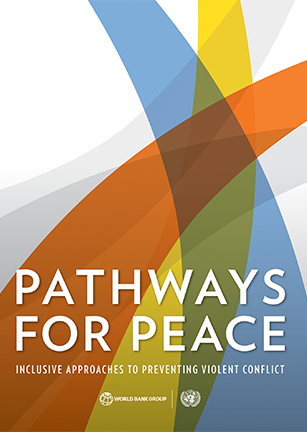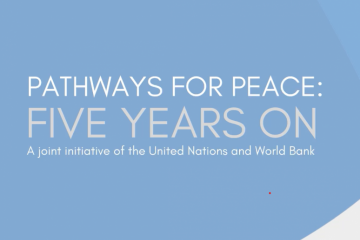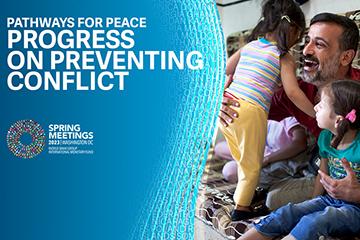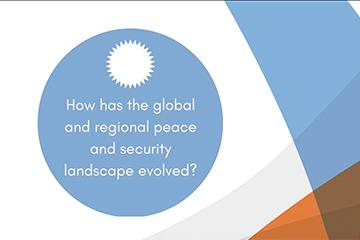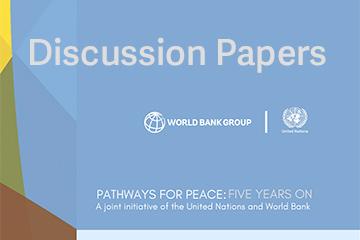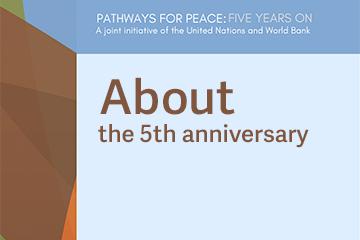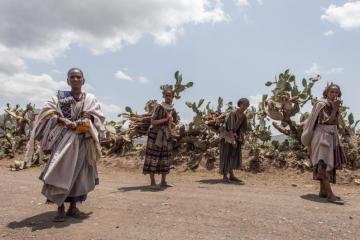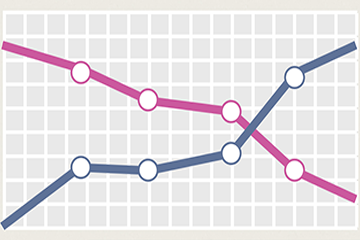Prevention is a long-term process of reinforcing and steering a society’s pathway toward peace. This study amassed overwhelming evidence that prevention requires sustained, inclusive, and targeted attention and action. Deep changes are needed in the way national, regional, and international actors operate and cooperate so that risks of violent conflict are identified and addressed before they translate into crisis. However, few incentives now exist for this coordination, collaboration, and cooperation. Instead, preventive action often focuses on managing the accompanying crisis rather than addressing underlying risks, even when solutions to the underlying risk are available.
Pathways for Peace highlights three core principles of prevention.
- Prevention must be sustained over the time needed to address structural issues comprehensively, strengthen institutions, and adapt incentives for actors to manage conflict without violence. It is easy, but wrong, to see prevention as a tradeoff between the short and long term. Sustainable results require sustained investment in all risk environments, while development investments should be integrated into overarching strategies with politically viable short-term and medium-term actions. The need for sustainability requires balancing effort and resources so that action does not reward only crisis management.
- Prevention must be inclusive and build broad partnerships across groups to identify and address grievances that fuel violence. Too often, preventive action is focused on the demands of actors that control the means of violence and positions of power. In complex, fragmented, and protracted conflicts,
an inclusive approach to prevention puts an understanding of grievances and agency at the center of national and international engagement. It recognizes the importance of understanding people and their communities: their trust in institutions, confidence in the future, perceptions of risk, and experience of exclusion and injustice.
- Prevention must proactively and directly target patterns of exclusion and institutional weaknesses that increase risk. Successful prevention depends on pro-active and targeted action before, during, and after violence. Modern conflicts arise when groups contest access to power, resources, services, and security; alongside efforts to mitigate the impacts of violence and de-escalate conflict, preventive action must actively and directly target grievances and exclusion across key arenas of risk.
Devising National Strategies for Prevention
The state bears the primary responsibility for preventing conflict and shaping a country’s pathway toward sustainable development and peace. The following are some recommendations for effective national action in partnering for prevention.
Monitor the Risks of Conflict
Engaging early in preventive action requires a shift from early warning of violence and toward awareness of risk:
Identify real and perceived exclusion and inequality, which requires strengthening the capacity for identifying, measuring, and monitoring SDG indicators8
- Strengthen national early warning systems and design systems that can effectively influence early response by national actors at various levels
- Harness technology to improve monitoring, especially in remote and conflict-affected areas, including through application of ICT and real-time data collection methods • Ensure that surveys and data collection measure inequality, exclusion, and
perceptions and are conflict-sensitive and capacity-sensitive.9
Address Different Dimensions of Risk
National actors often deal with multiple risks simultaneously with limited budgets, political capital, and time:
- Bring institutions and actors together under a peace and development framework that prioritizes the risk of conflict
- Target risk spatially with investments and other actions in border and peripheral areas where grievances and violence may be more likely to exist
- Manage the impact of shocks when tensions are high
- Target action and resources to identified risks in arenas where exclusion and grievances arise over access to power, resources, services, and security and justice, and manage contestation and conflict by redistributive policies, among other possible actions.
Aligning Peace, Security, and Development for Prevention
One of the objectives of Pathways for Peace is to stimulate new thinking about the relationship of development, peace, and security—a relationship that takes concrete form in inclusive approaches to preventing conflict. A coherent strategy that can be sustained over time demands levels of integrated planning and implementation that are often challenging to development, security, humanitarian, and political actors. Each has comparative advantages at different stages of risk but sustained, inclusive, and targeted prevention requires that they coordinate more effectively. The following are some recommendations for better alignment.
Ensure that Security and Development Approaches Are Compatible and Mutually Supportive
Mutual support requires rebalancing growth and stability targets, as aggrieved groups
whose exclusion poses a conflict risk may not be the poorest and may not be in areas of high potential for economic growth. Where security interventions are warranted, social services and economic support should also be provided so that security forces are not the only interface between the state and the population.
Build Capacity and Allocate Resources to Ensure that Grievances Are Mediated Quickly and Transparently
Capacity building can be addressed through training, development of guidance, and strengthening of institutions. Support for national and local-level mediation can be integrated into planning and programming at the local level (Rakotomalala 2017).
Engage Actors beyond the State in Platforms for Dialogue and Peacebuilding
Many actors involved in conflict today are not directly accessible to state institutions or agents. Inclusive prevention entails a focus on strengthening the capacity of the society, not just the state, for prevention. Inclusive prevention is a bottom-up process that should involve as broad a spectrum of people and groups as possible. Coalitions should reflect the importance of young people, women, the private sector, and civil society organizations.
Adopt a People-Centered Approach
A people-centered approach should include mainstreaming citizen engagement in development programs and local conflict resolution to empower underrepresented groups such as women and youth. Service delivery systems should seek to make people partners in the design and delivery of public services through mainstreaming participatory and consultative elements for all planning and programming in areas at risk of violent conflict.
Overcoming Barriers to Cooperation in Prevention
Development organizations need to adjust incentives toward prevention. International development actors and multilateral development banks are constrained by mandates, intergovernmental agreements, and institutional culture from engaging on sensitive risks with governments. Development organizations should ensure that prevention has a higher priority in their programming.
Share Risk Assessments
In the absence of a coherent process to share data, many organizations carry out assessments of different risks using different indicators. These data mostly remain internal to these organizations and are not shared with the national government or other relevant national actors, mostly because this information is often seen as politically sensitive. Risk monitoring and assessment methodologies also must become more widely shared, with specific focus on developing shared metrics across the various risks to development, peace, and security.
Commit to Collective Mechanisms to Identify and Understand Risks at Regional, Country, and Subnational Levels
The absence of effective mechanisms translates into ad hoc and fragmented actions among international partners.
Ensure That Joint Risk Assessments Articulate Jointly Agreed Priorities
Joint risk assessments should be based on agreed indicators that allow trends to be monitored over time. For example, the joint United Nations–European Union– World Bank Recovery and Peacebuilding Assessment offers one such approach for aligning priorities. Currently used mostly during and immediately following conflict, this approach could be used further upstream and developed into joint platforms for prioritizing risk.
Build Stronger Regional and Global Partnerships
Efforts should include the strengthening of regional analyses and strategies for prevention and the sharing of risk analyses to the extent possible at a regional level.
Explore New Investment Approaches for Prevention
Financing for prevention remains risk averse and focused on crises. As a result, current models are too slow to seize windows of opportunity and too volatile to sustain prevention. Complex and multilevel efforts are often constrained by the lack of needed and readily available resources, resulting in ad hoc resource mobilization attempts to generate financing from donors, often resulting in delayed and suboptimal responses. Options include strengthening support for financing national capacity for prevention, combining different forms of financing, and strengthening financing for regional prevention efforts.
8. Several SDG targets and indicators could have relevance for assessing risks of horizontal inequality. Specifically, key core targets include SDG5 (5.1: End all forms of discrimination against all women and girls everywhere); SDG10 (10.2: By 2030, empower and promote the social, economic, and political inclusion of all, irrespective of age, sex, disability, race, ethnicity, origin, religion, or economic or other status; 10.3: Ensure equal opportunity and reduce inequalities of outcome, including by eliminating discriminatory laws, policies, and practices and promoting appropriate legislation, policies, and action in this regard); and SDG16 (16.3: Promote the rule of law at the national and international levels and ensure equal access to justice for all; 16.7: Ensure responsive, inclusive, participatory, and representative decision making at all levels).
9. Implementing the monitoring of perceptions and issues such as horizontal inequality requires several important safeguards to be in place. Governments and other actors can use questions on perceptions, identity, and aspirations to identify certain groups, target them for security purposes, deny people’s rights, or support implementation of exclusionary policies. It is essential that very strong attention be given to protecting individual and collective rights of the population interviewed and the people collecting the information.
